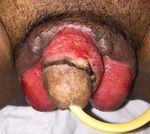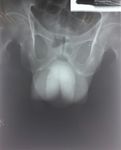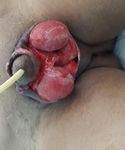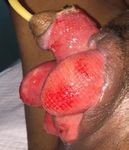A Type 2 Diabetes Patient Who Suffered With Fournier's Gangren - Universitas Airlangga
←
→
Page content transcription
If your browser does not render page correctly, please read the page content below
CURRENT INTERNAL MEDICINE RESEARCH AND PRACTICE SURABAYA JOURNAL, VOLUME 02 NO.1 JANUARY 2021 6
CASE REPORT
A Type 2 Diabetes Patient Who Suffered With Fournier’s
Gangren
Kholidatul Husna1,, Hermina Novida2*
1
Department of Internal Medicine, Faculty of Medicine, Universitas Airlangga – Dr. Soetomo General Hospital Surabaya,
Indonesia.
2
Division Endocrinology and Metabolic, Department of Internal Medicine, Faculty of Medicine, Universitas Airlangga – Dr.
Soetomo General Hospital Surabaya, Indonesia.
ABSTRACT
Diabetes mellitus increases the risk of infection, including Fournier’s gangrene. Fournier’s gangrene (FG) is rare, with an average incidence of
1.6 cases per 100,000 population per year. We report a case of a 60-year-old presented with the history of wounds of the buttocks, penis, and
scrotum. The patient had a history of uncontrolled diabetes mellitus for 3 years. There were perianal abscesses and necrotic tissue on the penis
and scrotum. Radiological evaluation in the patient showed the presence of gas-forming in the scrotal area. Therefore, incision and drainage
procedures with necrotomy and debridement were performed, together with antibiotics and blood glucose regulation, followed by the closure
of the defect with skin graft and flap use. The patient was discharged with an improved clinical condition.
Keywords: Diabetes mellitus, Fournier’s gangrene, Perianal abscesses, Skin graft
Correspondence: Hermina Novida
E-mail: hermina-n@fk.unair.ac.id
Article history: •Received 11 December 2020 •Received in revised form 27 January 2021 •Accepted 28 January 2021
INTRODUCTION and purulent drainage. The patient also complained of fever,
Diabetes mellitus (DM) increases the risk of infection, including lower abdominal pain, nausea and vomiting in the last 1 day.
gangrene (Tjokroprawiro, 2017). Fournier’s gangrene (GF) is The defecation was normal. The urination was smooth, and
progressive necrotizing fasciitis of the perineal, perianal or frequent urination in the last 3 years. He also complained of
genital areas. Fournier’s gangrene was first discovered in 1883 easily hungry and thirsty, and weight loss of 15 kg in the last
by a French venereologist, Jean Alfred Fournier (Vargas et al., 2 years. There were no complaints of wounds of the feet or
2011). This case is quite rare and mainly affects male patients blurred vision. Patient had been diagnosed with type 2 diabetes
with a peak incidence over 50 years of age (Sorensen et al., for 3 years, but he did not take any medications. He had no
2009). Although initially described as idiopathic gangrene, the history of high blood pressure, stroke, or heart disease. There
cause can be identified in 75-95% of cases. The most common was no family history of diabetes.
cause is a perianal abscess in uncontrolled diabetes (Nisbet & The physical examination showed that the general
Thompson, 2002; Hirugade et al., 2016). Fournier’s gangrene condition was moderate illness, compos mentis (GCS 4-5-6)
is an emergency case of general surgery and urological with blood pressure 110/70 mmHg, heart rate 110x/minute
department because it has a very sudden onset, progressive (regular and adequate pulse), respiratory rate 20x/minute, and
disease and causes septic complications. FG’s mortality rate axillary temperature 38.1oC. Head, neck, and chest examination
is quite high (20-40%), so an early diagnosis and prompt was within normal limit. There was erythemal skin in lower
treatment are essential because it determines the patient’s abdomen area with normal bowel sounds. There were perianal
prognosis (Martinschek et al., 2012). We reported a patient abscesses and necrotic tissue on the penis and scrotum. Rectal
with type 2 diabetes who had Fournier’s gangrene and perianal touche examination wasx within normal limit (Figure 1).
abscess due to trauma.
The laboratory examination showed: Hb 12. 0 g/dl;
CASE REPORT leukocyte 13,840/µL; granulocyte 88. 6%; platelet 546,000/
µL; RPG (random plasma glucose) 428 mg/dl; AST 20 U/L;
A 60-year-old male came to the emergency room of Dr. ALT 22 U/L; BUN 25 mg/dl; serum creatinine 1. 24 mg/dl;
Soetomo Hospital with a chief complaint of wounds of the albumin 2. 66 g/dl ; CRP 313. 43 mg/L; Na 134 mmol/l; K 4.
buttocks, penis, and scrotum 5 days before admission, and it 5 mmol/l; Cl 96 mmol/l. Urinalysis: yellow, SG 1. 010; pH 6.
was getting worse. The patient had fallen from the tree, and the 0; prot (+2); gluc (+3); uro 16 mmol/L; bil (+1); nit (-); leu (-);
buttocks were swollen, painful, reddish and felt warm. There bld (-); leut 2-5/hpf; ery 10-15/hpf. Blood gas analysis: pH 7.
was wound in buttocks widened up to the scrotal, penis area, 54; PCO2 28 mmHg; PO2 72 mmHg; HCO3 24 mmol/l; BE 1.
Available at https://e-journal.unair.ac.id/CIMRJ
DOI: 10.20473/cimrj.v2i1.23806CURRENT INTERNAL MEDICINE RESEARCH AND PRACTICE SURABAYA JOURNAL, VOLUME 02 NO.1 JANUARY 2021 7
1, SO2 96. 3%. ECG: sinus rhythm 108x/minute, normal axis. day, fluid balance I=O+500, NaCl 0. 9% infusion 1,500
Chest x-ray was normal. The pelvic x-ray showed the present ml/day, ceftriaxone 1 gram/12 h intravenous injection,
of gas forming in scrotal area (Figure 2). metronidazole 500 mg/8 h intravenous injection, prandial
insulin 8 unit subcutaneous injection 3 times daily,
ketorolac 30 mg/8 h intravenous injection, and wound care.
The patient was monitored for complaint, vital signs, and
blood glucose.
On the 4th day of admission, the patient complained
of surgical wound pain, and fever became better. Vital
signs were within normal limit. The patient had a perianal
drain and rectal tube, and wound condition showed in
Figure 4 on the third day of wound care. The wound was
in good condition, with no pus, and visible granulation
Figure 1. Initial physical examination tissue. Urine production was 1,500 ml/24 h. Laboratory
finding: FPG 297 mg/dl; albumin 2.13 g/dl. The pus
culture result: Staphylococcus aureus dan Klebsiella
pneumoniae, resistance for ceftriaxone. The tissue culture
result: Staphylococcus pasteuri. The patient was then given
cefotaxime 1 gram/8 h based on sensitive culture result,
basal insulin 10 unit subcutaneous injection once daily, and
albumin transfusion.
Figure 2. Pelvic x-ray showed gas formation in scrotal area.
Interdepartmental consultations, 1) Urology: the patient Figure 4. On third day of wound care
was diagnosed with Fournier gangrene, suggested to perform On the 14th day of admission, the patient had no
necrotomy and debridement; 2) Digestive: the patient was complaints with stable vital signs. The wound was in good
diagnosed with perianal abscesses, the patient was planned to condition, with no pus, and visible granulation tissue. Urine
undergo an emergency incision and drainage procedure. production was 1,800 ml/24 h. Laboratory finding: Hb 10.
Based on anamnesis, physical, laboratory & radiology 3 g/dl; leukocyte 7, 900/µL; granulocyte 72%; platelet
examination, the patient has been diagnosed with Fournier’s 580,000/µL; FPG 126 mg/dl; 2h-PG 166 mg/dl; AST 20
gangrene + perianal abscesses + type 2 diabetes + U/L; ALT 22 U/L; BUN 26 mg/dl; serum creatinine 0.95
hypoalbuminemia. Blood glucose was regulated with insulin mg/dl; albumin 3.3 g/dl. Blood culture was sterile. The
correction 4 unit intravenous injection three times and NaCl patient was consulted for the closure of the defect to the
0.9% infusion 1,000 ml in an hour. Then the patient has plastic surgery department. The antibiotics have been
undergone an emergency join surgery of digestive and urology discontinued.
surgeon: incision and drainage procedure, also necrotomy and
On the 35th day of admission, the patient had undergone
debridement procedure (Figure 3).
plastic procedure (closure of the defect with thick STSG
(Split Thickness Skin Grafts) and bilateral pudendal
perforator artery flap). After one week of the closure of the
defect, the flap was in good condition: viable, warm, and
the color was the same as the surrounding skin (Figure 5).
Figure 3. After necrotomy and debridement procedure.
Figure 5. After skin graft procedure.
The patient was planned to perform serial blood glucose
during and post-surgery, fasting plasma glucose (FPG), 2 The patient was advised to control the endocrinology
hours plasma glucose (2h-PG), blood, and pus cultures. metabolic of internal medicine, plastic surgery, urology,
After surgery, the patient was given G diet 2,100 kcal/CURRENT INTERNAL MEDICINE RESEARCH AND PRACTICE SURABAYA JOURNAL, VOLUME 02 NO.1 JANUARY 2021 8
and digestive outpatient clinics. The insulin medication was the presence of aerobic and anaerobic bacteria (Singh et al.,
continued: prandial insulin 8 unit subcutaneous injection 2016; Jeje et al., 2017).
three times daily, and basal insulin 10 unit subcutaneous This patient was a 60-year-old male, with the cause
injection once daily. of FG was trauma (falling from a tree) that resulting in
perianal abscess and extends to the scrotal and penis area.
DISCUSSION The pus culture results showed Staphylococcus aureus and
Fournier’s gangrene (FG) is progressive necrotizing Klebsiella pneumoniae bacteria growth, while the tissue
fasciitis of the perineal, perianal or genital areas. Diagnosis culture showed Staphylococcus pasteuri bacteria.
of Fournier’s gangrene is mainly based on clinical Fournier’s gangrene predisposing factors are
examination. The patients usually complaint of swelling general poor conditions such as malnutrition, use of
and pain in the pubic area, accompanied by fever. On immunosuppressants, alcohol, diabetes mellitus, chronic
physical examination, a systemic inflammatory response liver disease, and chronic kidney disease (Czymek et al.,
syndrome, severe sepsis, skin edema, erythema, ulcers, 2009; Martinschek et al., 2012). Uncontrolled diabetes is
necrosis, crepitus, and purulent drainage from the wound the most common predisposing factor for FG in 32 - 66%
can be found. Crepitation can be found in FG cases due cases (Nisbet & Thompson, 2002; Hirugade et al., 2016).
to anaerobic bacteria that produce exotoxins that cause According to the American Diabetes Association (ADA)
necrosis and gas formation. Other investigations can 2017, a diagnosis of diabetes can be made if it meets one of
be done to confirm the diagnosis. Laboratory findings the following criteria: 1. HbA1C ≥ 6.5%; 2. Fasting plasma
may indicate anemia, leukocytosis, thrombocytopenia, glucose ≥ 126 mg/dl; 3. 2-hour plasma glucose ≥ 200 mg/dl
electrolyte imbalance, hyperglycemia, acute kidney injury, with oral glucose tolerance test; 4. Random plasma glucose
and hypoalbuminemia. A radiological examination can be ≥ 200 mg/dl with classic symptoms or hyperglycemic
carried out if the diagnosis is still in doubt, but this should crisis (ADA, 2017). Persistent hyperglycemia in
not delay surgical treatment. Plain radiographs of Fournier’s diabetes increases the aerobic fermentation to anaerobic
gangrene can show gas in the soft tissue, characterized by environment; gas is produced, and the oxidation potential
hyperlusency (Malikarjuna et al., 2012; Jeje et al., 2017). decreases. The anaerobic environment increases infection
Fornier’s gangrene diagnosis in this patient was by anaerobic bacteria. Hyperglycemia also decreases the
made based on history, physical examination, and other immune system by reducing cellular immunity, chemotaxis
investigations. The patient complained of the scrotal and activity, and phagocytosis, thereby prolonging the
penis area wound extending from the buttocks due to healing process. The increased tissue glucose, poor tissue
trauma. He also complained of fever. From the physical perfusion, and weak immune response in diabetic patients
examination, it was found necrotic tissue and crepitus on lead to more progressive infection and can progress rapidly
the penis and scrotum. On laboratory examination, there to sepsis (Nisbet & Thompson, 2002; Singh et al., 2016;
were leukocytosis, hyperglycemia, and hypoalbuminemia. Jeje et al., 2017).
While the pelvic x-ray showed the present of gas forming The predisposing factor for FG in this patient was
in scrotal area. diabetes mellitus. The patient had a history of uncontrolled
Fournier’s gangrene mostly affects males, with a peak diabetes for three years, accompanied by classical symptoms
incidence at 40-70 years of age. The necrosis process (polyuria, polydipsia, and weight loss) and random plasma
usually originates from infection in the anorectal area (13- glucose 428 mg/dl. The patient’s HbA1C was 7.8%, so the
50%), urogenital tract (17-87%), while others from local patient was diagnosed with type 2 diabetes mellitus.
trauma or skin infection around the genital area (Czymek FG management principles are to improve the patient’s
et al., 2009). The causes of the anorectal area include general condition, administration of antibiotics, and
perianal abscess, anal fissure, and bowel perforation surgical debridement. In patients with hypoperfusion or
resulting from colorectal injury or malignancy, colonic systemic organ failure, immediate resuscitation to restore
diverticulitis, and appendicitis. In the urogenital tract, normal organ perfusion should take first than diagnostic
FG causes include infection of the bulbourethral gland, procedures. Antibiotics that can be given are systemic
urethral injury, iatrogenic injury secondary to manipulation broad-spectrum antibiotics that include staphylococci,
of urethral strictures, epididymitis, orchitis, or lower streptococci, Enterobacteriaceae, and anaerobes.
urinary tract infection. Whereas in dermatology, the causes Commonly used antibiotic combinations are penicillin or
include suppurative hidradenitis and trauma (Sughishita et clindamycin for streptococcal species, third-generation
al., 2008; Altarac et al., 2012). The scrotum is the most cephalosporins or carbapenems for gram-negative bacteria,
common infection site at initial diagnosis, but FG also and metronidazole for anaerobes bacteria. A surgical
occurs in the perineal area, penis, and lower abdomen. debridement is required for definitive diagnosis and excision
The scrotum is prone to necrosis because its blood flow of necrotic tissue. Gangrene gas formation can reach 1 cm2
is relatively limited. Anorectal and urogenital trauma per hour, so surgical debridement must be done as soon
can be the port of commensal bacteria’s entry, such as as possible. Patients with uncontrolled diabetes require
Staphylococcus spp. and Escherichia coli into the perineal more aggressive wound care and extensive debridement.
area that become virulent and cause tissue damage due to Sometimes, it is necessary to make urine diversion through
impaired cellular immunity, followed by thrombosis and cystotomy or stool diversion by performing a colostomy to
decreased blood flow that is resulting in ischemia. Tissue avoid contamination, but this procedure is still controversial
hypoxia increases the proliferation of anaerobic bacteria and should be applied according to the individual patient’s
and fascia necrosis so that the infection is polymicrobial in condition. Surgical reconstruction may be performed,CURRENT INTERNAL MEDICINE RESEARCH AND PRACTICE SURABAYA JOURNAL, VOLUME 02 NO.1 JANUARY 2021 9
depending on the size of the wound. Primary suturing can This patient’s management includes crystalloid infusion
be performed mainly in flexible skin, such as the scrotum, and blood sugar regulation with intravenous insulin
but if the wound is large enough, skin grafts and multiple because the patient was planned to perform an emergency
flaps can be used. Therapy with hyperbaric oxygen can also debridement procedure. Before surgery, the patient was
be used as part of FG management (Heyn & Theron, 2007; given intravenous antibiotics, ceftriaxone 1 gram and
Malikarjuna et al., 2012; Singh et al., 2016). metronidazole 500 mg, and a urine catheter installation.
Perioperative insulin therapy generally depends on the The patient has then undergone a joint surgery by urological
type of diabetes, the type of surgical procedure, previous and digestive surgeons, necrotomy and debridement in
pharmacological therapy, and glycemic control status the necrotic area, and abscess drainage. After surgery, the
before the surgical procedure. Before surgical procedures, patient was given fluid infusion as needed, G diet G 2100
the target blood glucose is 140-180 mg/dl (PERKENI, kcal/day, antibiotics, basal and prandial insulin that dose
2006). In hyperglycemia, especially in an emergency case, adjusted based on latest blood glucose results, albumin
it is necessary to immediately reduce blood sugar levels transfusion, and wound care. The patient underwent a
by administering correctional insulin, either intravenously plastic surgeon’s closure of defect procedure with a thick
or subcutaneously (ADA, 2017). Giving insulin during STSG (Split Thickness Skin Grafts) technique and bilateral
hospitalization aims to control blood glucose levels more pudendal perforator artery flap.
intensively to inhibit the suppression of the immune Fournier’s gangrene is an infectious disease with
response due to hyperglycemia and accelerate the healing high mortality (20-40%). Several previous studies have
process of infection. Several previous studies have developed a method to estimate the patient’s prognosis,
reported that insulin has anti-inflammatory effects (Jack one of which is the Fournier’s gangrene severity index
& George, 2002). Nutritional therapy in diabetic patients (FGSI) (Ochoa et al., 2010; Martinschek et al., 2012;
with gangrene can be given a G diet consisting of 60% Benjelloun et al., 2013). FGSI is a numerical score obtained
carbohydrates, 20% fat, and 20% protein; high arginine, from a combination of physiological hospital admission
25-35 g/day of fiber, 41 39-40.9 - 38.5-38.9 36-38.4 34-35.9 32-33.9 30-31.9 180 140-179 110-139 - 70-109 - 56-59 40-54 50 35-49 - 25-34 12-24 10-11 6-9 - 180 160-179 155-159 150-154 130-149 - 120-129 111-119 7 6-6.9 - 5.5-5.4 3.5-4 3-3.4 2.5-2.9 - 3 2-3.4 1.5-1.9 - 0.6-1.4 - 60 - 50-59.9 46-49 30-45.9 - 20-29.9 - 40 - 20-39.9 15-19.9 3-14.9 - 1-2.9 -
1000)
52 41-51.9 - 32-40.9 22-31.9 - 18-21.9 15-17.9CURRENT INTERNAL MEDICINE RESEARCH AND PRACTICE SURABAYA JOURNAL, VOLUME 02 NO.1 JANUARY 2021 10
the predisposing factor was uncontrolled diabetes. This Malikarjuna MN, Vijayakumar A, Patil VS, Shivswamy BS, 2012.
patient has been performed an emergency debridement, Fournier’s Gangrene: Current Practices. ISRN Sugery, 1-8.
blood glucose regulation, antibiotics, and reconstructive
Martinschek A, Evers B, Lampl L, Gerngroß H, Schmidt R, Spar-
surgery to discharge with an improved clinical condition.
wasser C, 2012. Prognostic aspects, survival rate, and pre-
The FGSI scoring system is used to predict Fournier’s disposing risk factors in patients with Fournier’s gangrene
gangrene patient’s outcome. The lower the score, the better and necrotizing soft tissue infections: Evaluation of clinical
the prognosis. outcome of 55 patients. Urologia Internationalis, 89:173-9.
Nisbet AA, Thompson IM, 2002. Impact of diabetes mellitus on the
CONFLICT OF INTEREST
presentation and outcomes of Fournier’s gangrene. Urolo-
The author declare there is no conflict of interest of this gy; 60: 775‑9.
study.
Ochoa G, Lira C, Macias V, 2010. Usefulness of Fournier’s gangrene
REFERENCES severity index: A comparative study. Revista Mexicana de
Altarac S, Katušin D, Crnica S, 2012. Fournier’s gangrene: Etiology Urologia, 70: 27-30.
and outcome analysis of 41 patients. Urologia Internation-
Perkumpulan Endokrinologi Indonesia (PERKENI), 2006. Petunjuk
alis, 88: 289-93.
Praktis Terapi Insulin pada Pasien Diabetes Melitus. Jakar-
American Diabetes Ascociation (ADA), 2017. Standard of Medical ta: PERKENI, 29-30.
Care in Diabetes. Diabetes Care, 1: S14-62.
Tjokroprawiro A, 2017. Formula Klinik Praktis (FKP) Dibidang Di-
Benjelloun EB, Souiki T, Yakla N, Ousadden A, Mazaz K, Louchi abetologi, Endokrinologi, Metabolisme, Fokus: Diabetes.
A, Kanjaa N, Taleb KA, 2013. Fournier’s Gangrene: Our Surabaya: Pusat Diabetes dan Nutrisi Surabaya, 5th edi-
Experience With 50 Patients and Analysis of Factors Af- tion.
fecting Mortality. World Journal of Emergency Surgery, 8
Singh A, Ahmed K, Aydin A, Khan MS, Dasgupta P, 2016. Fournier’s
(13): 1-5.
gangrene, A clinical review. Archivio Italiano di Urologia e
Czymek R, Hildebrand P, Kleemann M, Roblick U, Hoffmann M, Andrologia, 88 (3): 157-64.
Jungbluth T, 2009. New insights into the epidemiology and
Sorensen MD, Krieger JN, Rivara FP, Broghammer JA, Klein MB,
etiology of Fournier’s gangrene: A review of 33 patients.
Mack CD, Wessel H, 2009. Fournier’s Gangrene: popula-
Infection, 37: 306‑12.
tion based epidemiology and outcomes. Journal of Urolo-
Heyn CF, Theron PD, 2007. Fournier’s Gangrene. In: Markus Hohen- gy, 181: 2120-6.
feller, Emergencies in Urology. New York USA: Springer,
Sughisita Y, Nagashima M, Ooshiro M, Urita T, 2008. Fournier’s
50-59.
gangrene progressing from the buttocks to the scrotum fol-
Hirugade S, Patil HN, Hirugade SS, 2016. Fournier’s gangrene and lowing a perianal abscess. Journal of Infection and Chemo-
diabetes mellitus: Our experience with 50 patients. Interna- therapy, 14: 56-58.
tional Journal of Recent Trends in Science & Technology,
Vargas AH, Carbonell J, Osorio D, Garcia HA, 2011. Evaluation of
20 (2): 209-13.
Fournier’s necrosis in a high complexity hospital. General
Jack SD, George K, 2002. Management of diabetes mellitus in surgi- urology. Archives Espanoles de Urologia, 64: 948-52.
cal patients. Diabetes spectrum, 15 (1): 44-8.
Jeje AE, Mofikoya BO, Oliyide AE, 2017. Fournier’s gangrene and
perianal abscess: Is there a common denominator?. Journal
of Clinical Science, 14: 53-5.You can also read


























































